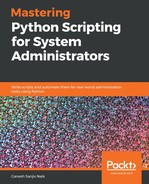The fill() function works similarly to textwrap.wrap, except it returns the data joined into a single, newline-separated string. This function wraps the input in text and returns a single string containing the wrapped text.
The syntax for this function is:
textwrap.fill(text, width)
-
text: Text to wrap.
-
width: Maximum length allowed of a wrapped line. The default value is 70.
Now, we will see an example of fill(). Create a fill_example.py script and write the following content in it:
import textwrap
sample_string = '''Python is an interpreted high-level programming language.'''
w = textwrap.fill(text=sample_string, width=50)
print(w)
Run the script and you will get the output as follows:
student@ubuntu:~/work$ python3 fill_example.py
Python is an interpreted high-level programming
language.
In the preceding example, we used the fill() function. The procedure is the same as what we did in wrap(). First, we created a string variable. Next, we created the textwrap object. Then, we applied the fill() function. Finally, we printed the output.
